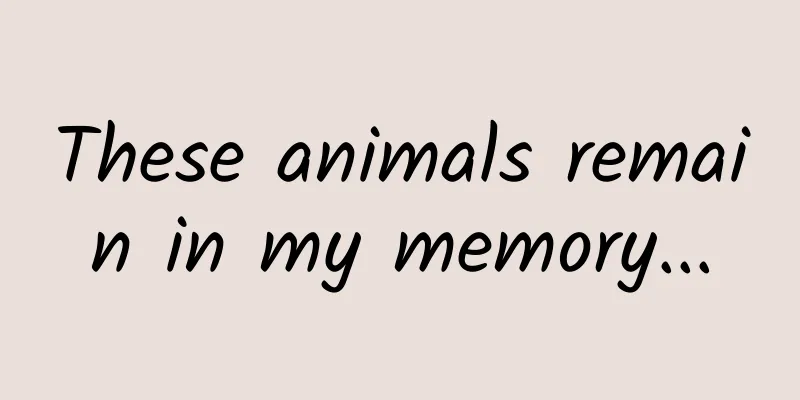These animals remain in my memory...

|
Recently, the World Conservation Union’s Red List of Threatened Species updated its report, announcing that the Chinese sturgeon is extinct and the Yangtze sturgeon is extinct in the wild. Source: Wei Qiwei, member of the IUCN Sturgeon Specialist Group The results of the IUCN (World Conservation Union) global sturgeon reassessment show that about two-thirds of sturgeon populations are critically endangered. Arne Ludwig, chairman of the IUCN Sturgeon Specialist Group, said, "The results are shocking and sad, but expected. The assessment shows that sturgeons still cannot get rid of the title of 'the world's most threatened group'." Species extinction is not uncommon. A BBC report said: "Since the first industrial revolution, the phenomenon of species extinction on Earth due to human activities has become increasingly prominent. Many animal species have disappeared forever. The endangered species list includes a quarter of mammals, more than a thousand bird species and tens of thousands of plant species. " In recent years, more than 37,000 species worldwide are on the verge of extinction, and 8 million tons of plastic waste eventually flows into the ocean every year... The survival status of creatures on Earth is not optimistic. 01 How many species are there on Earth? For centuries, humans have been searching for the diversity of life on Earth. From the depths of the Earth's crust to the peaks of the Himalayas, from tropical rainforests to the deep blue sea, the classification of plants, animals, and microorganisms has become increasingly detailed. In 2011, biologists from Hawaii and Canada estimated that the number of species on Earth is about 8.7 million, with the actual number ranging from 7.4 million to 10 million. However, some researchers pointed out that the previous assessment data was obviously underestimated, and all previous survey reports ignored microorganisms and used unreliable inference techniques. "Assessing the number of species on Earth is a huge challenge," said Jay Lennon, a professor at Indiana University. "Our data, combined with the largest database of ecological models, will provide a rigorous new count of the Earth's microbial species. Microorganisms are too small to be seen with the naked eye and include single-celled organisms, bacteria, archaea and some fungi." Therefore, although humans have spared no effort to explore the biodiversity of the earth , there is still no definite data on the specific species information on the earth. Although human society is constantly improving in science and technology, the acquisition of resources such as water, food, medicine, and fuel still depends on the most basic natural ecosystem. In 2020, the pandemic swept the world. The invasion of the virus made people re-examine the relationship between man and nature, and once again emphasized the importance of the earth's ecology and species diversity. Data shows that the earth's biodiversity has been declining in recent years. 02In the past 40 years, the Earth's biodiversity has decreased by 68% In September 2020, UN Secretary-General Guterres stated at the Biodiversity Summit that more than 60% of the world's coral reefs are on the verge of extinction due to overfishing, destructive practices and climate change. Excessive consumption, population growth and intensive agriculture have led to a sharp decline in wildlife populations. The rate of species extinction is accelerating, with 1 million species currently threatened or endangered. The "Living Planet Report 2020" was released by the World Wildlife Fund every two years. The report shows that the average size of monitored mammals, birds, amphibians, reptiles and fish populations decreased by 68% between 1970 and 2016. Globally, biodiversity loss is most evident in Latin America, which has the world's largest tropical forests, with a 94% drop in species richness over 40 years, the most serious region in the world. Changes in land and ocean use, including habitat loss and degradation, are the biggest threats to biodiversity. Take Latin America as an example. The Amazon rainforest is one of the most biodiverse ecosystems on Earth, with more than 3 million species living in the rainforest and more than 2,500 tree species (about 1/3 of all tropical trees on Earth) jointly maintaining this vibrant ecosystem. But in this rainforest, species extinction rates are unprecedented. The United Nations estimates that 1 million species are on the verge of extinction. From August 2018 to July 2019 alone, the Amazon region lost more than 9,842 square kilometers of forest, with deforestation reaching a decade-high peak. Human occupation of land, expansion of industrial and agricultural land, and overexploitation of grasslands, rainforests, and wetlands are the main reasons for the decline of species in the region. Compared with oceans and forests, freshwater biodiversity is losing at a faster rate. According to the Living Planet Index 2020, nearly 90% of the world's wetlands have disappeared since 1700, which has had a profound impact on freshwater biodiversity. The number of 944 freshwater species and 3,741 populations included in the Living Planet Index (LPI) has declined by an average of 84%. Among these freshwater creatures, larger species are more vulnerable. For example, some creatures weighing more than 30 kilograms, such as sturgeons, Yangtze finless porpoises, and otters, have seen their populations decline sharply due to overexploitation by humans. Between 2000 and 2015, the catch of 78% of species in the Mekong River declined, and the decline was more obvious for medium and large species. Although humans have been working to mitigate climate change in recent years, rising global temperatures, rising sea levels and extreme weather have already had an impact on species diversity. Ecological and species evolution is very slow. If climate change is very drastic and biological evolution cannot adapt to this speed, the risk of species extinction can only be "forced" to accelerate. 03Nearly 40,000 species in the world are on the verge of extinction The "Living Planet Report 2020" points out that global terrestrial biodiversity is currently in danger. The global average biodiversity intactness index is only 79%, far below the safety limit of 90%, and is still declining. The World Conservation Union's Red List of Threatened Species classifies species into categories such as "extinct," "extinct in the wild," "critically endangered," "endangered," and "vulnerable," based on the rate of decline in species numbers, total species, and geographical distribution. The latest Red List released by the World Conservation Union shows that 38,543 species are currently endangered, accounting for about 28% of all assessed species. Here are some of the animals that have become extinct or endangered in recent years, so we can remember what they looked like: The extinction of every species is a tragedy ANIMAL CROSSING We still have a lot to do Comprehensive compilation: CCTV News Client, Beijing News, Sanlian Life Weekly Produced by Beijing Association for Science and Technology Media Center |
<<: Tiangong already has Hall thrusters, so why is it necessary to transport chemical fuel up there?
Recommend
How to build an advertising strategy system?
When placing advertisements, operators need to ke...
Volkswagen's old problem: Beijing Hyundai recalls a large number of Tucson due to dual-clutch problems
Many car-savvy friends know that dual-clutch tran...
Biohazard in the rainforest! The terrifying poison dart frog is really poisonous...
(Image from copyright gallery) Deep in the dense ...
What are the functions of WeChat Beauty Mini Program? How much does it cost to develop a skin care product mini program?
The most profitable industry nowadays is the &quo...
Insights into new marketing trends in 2022
2022 is getting closer and closer. Looking back a...
Have you ever seen a supermoon that can cause an earthquake?
The supermoon appeared in the night sky on the ev...
Huawei files lawsuit against FCC, alleging it violates U.S. Constitution
[[284776]] On December 5, Huawei's Shenzhen h...
Friends who fart frequently, pay attention to these 7 things!
How many of you fart too much? It’s okay to fart ...
How to plan a promotional event that will attract a lot of people’s participation? Just read this one
This article introduces four strategies for plann...
You must know these 3 mainstream APP promotion methods!
In recent years, with the development and growth ...
Case Analysis: How to use the AARRR model to increase user growth?
This article takes Luckin Coffee as an example. I...
A quick overview of scientific and technological achievements on the horizontal screen | Mengtian Laboratory Module and China Space Station
China's space station construction It is the ...
Internet Advertising: Real-time Bidding RTB Process!
At present, all kinds of advertisements are every...
Why is the effect of information flow advertising worse after targeted advertising?
We all know that the first step in doing informat...
![[Cultivation Program] In the hot summer, insects have a "cool way" to escape the heat](/upload/images/67f2644aac0e8.webp)








